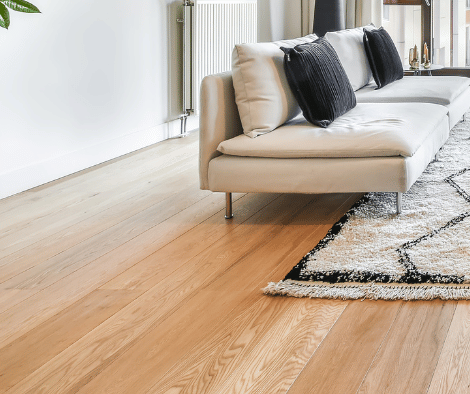Can My Hardwood Floors Be Refinished?

Can My Hardwood Floors Be Refinished? A Comprehensive Guide from Choice Hardwoods
By Choice Hardwoods
Hardwood floors are a beautiful and long-lasting addition to any home, providing warmth, character, and timeless appeal. Over time, however, even the most durable hardwood floors will show signs of wear. Whether it’s from foot traffic, scratches, spills, or just the natural aging of the wood, many homeowners will eventually consider refinishing their hardwood floors to restore their original beauty. But can every type of hardwood floor be refinished?
At Choice Hardwoods, we understand that refinishing is an investment, and you want to ensure that it’s the right choice for your floors. While solid hardwood floors are generally well-suited for refinishing, the answer is a little more complicated when it comes to engineered hardwood floors. Not all hardwood floors are created equal, and knowing the difference between these two types of flooring is crucial in determining whether refinishing is a feasible option.
In this article, we’ll discuss the different types of hardwood floors, the refinishing process for each, and the considerations you need to keep in mind when deciding if your floors can be refinished. We’ll also touch on the key distinctions between solid hardwood and engineered hardwood, and help you determine the best course of action for your specific floors.
1. What is Hardwood Flooring?
Before diving into whether or not hardwood floors can be refinished, let’s first understand the two main types of hardwood flooring: solid hardwood and engineered hardwood. Both are popular choices for homeowners, but they are quite different in terms of construction and durability.
Solid Hardwood: This is the traditional type of hardwood flooring that is made from a single piece of wood. Solid hardwood boards are milled from one solid piece of timber, and their thickness typically ranges from 3/4 inch to 5/8 inch. They are highly durable, can be sanded and refinished multiple times, and offer a rich, authentic look.
Engineered Hardwood: Engineered hardwood consists of multiple layers of wood. The top layer is a real wood veneer, often made of hardwood species like oak, maple, or walnut, but beneath that veneer are layers of plywood or high-density fiberboard (HDF). These multiple layers are pressed together using a cross-grain construction, which makes engineered hardwood more stable and less susceptible to moisture or temperature changes compared to solid hardwood. Engineered hardwood typically comes in thinner options, with overall thickness ranging from 3/8 inch to 1/2 inch.
2. Can Solid Hardwood Floors Be Refinished?
When it comes to solid hardwood floors, the answer is typically a resounding yes. Solid hardwood is one of the most refinishable flooring options available. Here’s why:
Durability and Thickness
One of the main reasons solid hardwood floors are ideal for refinishing is their thickness. Solid hardwood floors are typically thicker than engineered hardwood floors, which means they have more wood to work with. This thickness allows for multiple sanding and refinishing sessions over the course of the floor’s lifetime. Even if your solid hardwood floor has experienced significant wear or deep scratches, sanding it down to the raw wood can help restore its original beauty.
Most solid hardwood floors are 3/4 inch thick, which gives plenty of material to work with. Even if the floor has been refinished multiple times before, you can generally sand and refinish them 4-6 times throughout their lifespan. The more wood that’s available, the more refinishing sessions the floor can endure.
Benefits of Refinishing Solid Hardwood
Restores the Natural Beauty: Refinishing solid hardwood floors removes the old, worn-out finish, which can often become scratched, scuffed, or discolored. Once sanded and refinished, the floor looks as good as new, with a rich, glossy surface that highlights the natural beauty of the wood grain.
Repairs Minor Damage: Small scratches, dents, and wear patterns can be removed during the sanding process, leaving a smooth, clean surface. Deep gouges or stains, on the other hand, may require a bit more work and may not be fully repairable depending on their severity.
Long-Lasting: Solid hardwood floors are incredibly durable, and refinishing them helps to extend their life. With the right care and attention, your solid hardwood floors can last for decades, even centuries.
Customization: Refinishing allows you to change the color of the floor, as you can choose from a variety of stains and finishes. If you want to change the look of your space, refinishing is an easy way to do so without having to replace the entire floor.
When Should Solid Hardwood Floors Be Refinished?
While solid hardwood floors can usually be refinished, they should be refinished only when necessary. If your floor is too damaged, such as from heavy water exposure, or if the wood has become too thin due to repeated refinishing, it might not be the best candidate for refinishing. Here are some signs that your solid hardwood floor may need refinishing:
Dullness: If your floors have lost their luster and appear dull, it may be time for a refinish. This is a common sign of wear that can be easily addressed with a new coat of polyurethane.
Scratches and Scuffs: Minor surface scratches and scuffs are common on high-traffic floors. These imperfections can be removed through the sanding process.
Discoloration: If your floors are beginning to show discoloration or staining from water damage or sunlight, refinishing may restore their original color.
Deep Wear: If the finish has worn through in certain areas, leaving the wood exposed, refinishing will help restore the finish and protect the wood from further damage.
In general, solid hardwood floors can be refinished several times throughout their life, depending on their condition and the amount of wood remaining after each sanding.
3. Can Engineered Hardwood Floors Be Refinished?
When it comes to engineered hardwood floors, the answer is more complicated. While some engineered hardwood floors can be refinished, others cannot. The critical factor that determines whether or not an engineered hardwood floor can be refinished is the thickness of the top hardwood veneer.
Engineered Hardwood Construction
As mentioned earlier, engineered hardwood is made up of multiple layers. The top layer is a veneer of real hardwood, while the layers beneath it are typically plywood or HDF (high-density fiberboard). The thickness of this veneer is crucial because it determines how much wood is available to sand off. In engineered hardwood, the veneer is typically much thinner than the solid wood of traditional hardwood floors.
Here’s where the key distinction comes in:
Thick Veneer (about 2mm or more): If the veneer of your engineered hardwood is thick enough, it can handle one or two refinishing jobs. Floors with a thicker veneer (around 2mm or more) allow for some sanding to remove the old finish and smooth out the surface. However, even if the veneer is thick enough to refinish, it’s important not to sand too aggressively, as you risk damaging the veneer and exposing the plywood layer beneath.
Thin Veneer (less than 2mm): Many engineered hardwood floors come with a very thin veneer, sometimes as thin as 1mm. Floors with such a thin veneer are not suitable for refinishing. Sanding down these floors would result in sanding through the veneer and damaging the underlying plywood layer, rendering the floor irreparable.
What Happens When the Veneer is Too Thin for Refinishing?
If the veneer is too thin to refinish, attempting to sand the floor can cause more harm than good. The veneer could wear away, exposing the plywood or fiberboard underneath, which cannot be sanded or refinished. Once the top veneer is compromised, the floor is essentially damaged beyond repair.
This is one of the main drawbacks of engineered hardwood compared to solid hardwood. While engineered hardwood offers greater stability and resistance to moisture, it doesn’t have the same ability to handle multiple refinishing jobs due to the limited thickness of its veneer.
How to Determine If Your Engineered Hardwood Can Be Refinished
If you’re unsure whether your engineered hardwood floor can be refinished, there are a few ways to check:
Consult the Manufacturer’s Guidelines: The first thing you should do is check with the manufacturer or consult the product’s specifications. Many manufacturers provide guidelines on how many times their engineered hardwood floors can be refinished, if at all.
Measure the Veneer Thickness: If you’re able to, measure the thickness of the hardwood veneer. A thickness of 2mm or more typically indicates that the floor can handle one or two refinishing jobs.
Inspect the Edges: If the edges of your floor are exposed (for example, in a closet or under a baseboard), you may be able to see how thick the veneer is. A thicker veneer will be visible as a distinct layer of real wood, whereas a thinner veneer may look like just a thin layer with less definition.
Consult a Professional: If you’re uncertain whether your engineered hardwood floors can be refinished, it’s always best to consult a professional like Choice Hardwoods. We can assess the condition of your floors and help determine whether refinishing is a viable option.
4. Factors to Consider Before Refinishing Any Hardwood Floor
Before deciding to refinish either solid or engineered hardwood floors, there are a few factors to consider:
Condition of the Wood: If the wood is severely damaged, warped, or worn beyond repair, refinishing may not restore it to a satisfactory condition. In cases of deep water damage, extreme warping, or excessive wear, replacing the floor may be a better option.
Desired Outcome: Refinishing can restore a floor’s appearance, but it won’t fix structural issues or address problems like squeaking. If you’re hoping to fix other problems, such as gaps between boards or loose planks, you may need to address those separately.
Cost and Effort: Refinishing can be a labor-intensive process. If you’re not prepared to commit the time and effort required for a DIY job or don’t want to invest in professional services, it’s important to weigh the costs against the benefits.
5. Conclusion
At Choice Hardwoods, we understand the value of quality hardwood flooring and the importance of knowing whether your floors can be refinished. While solid hardwood floors are generally perfect candidates for refinishing, engineered hardwood floors require more careful consideration. If your engineered hardwood floor has a thick enough veneer (around 2mm or more), it may be refinishable, but floors with a thin veneer should not be sanded.
Whether your floors are solid or engineered, refinishing can restore their beauty, protect them from future damage, and extend their lifespan. If you’re unsure whether your floors can be refinished or need expert advice on the best course of action, the team at Choice Hardwoods is here to help. We offer professional refinishing services and can assess your flooring to determine the best approach for achieving the best possible results.
Contact us today to schedule a consultation and learn more about how we can restore the beauty and durability of your hardwood floors

